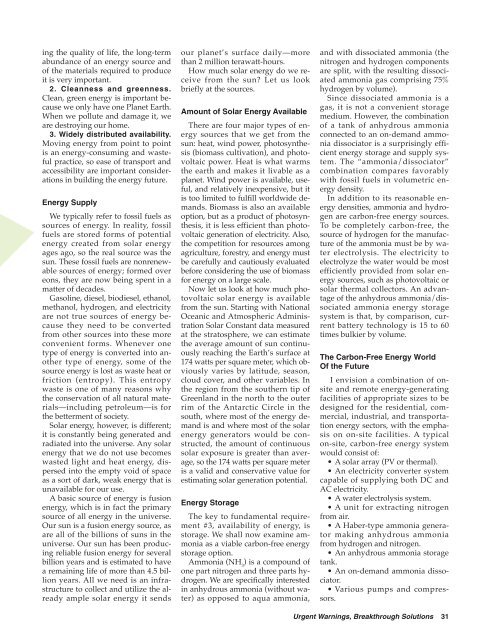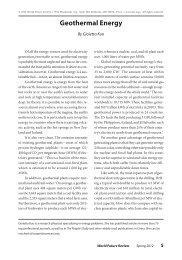Urgent Warnings, Breakthrough Solutions, Second Edition
Urgent Warnings, Breakthrough Solutions, Second Edition
Urgent Warnings, Breakthrough Solutions, Second Edition
Create successful ePaper yourself
Turn your PDF publications into a flip-book with our unique Google optimized e-Paper software.
ing the quality of life, the long-term<br />
abundance of an energy source and<br />
of the materials required to produce<br />
it is very important.<br />
2. Cleanness and greenness.<br />
Clean, green energy is important because<br />
we only have one Planet Earth.<br />
When we pollute and damage it, we<br />
are destroying our home.<br />
3. Widely distributed availability.<br />
Moving energy from point to point<br />
is an energy-consuming and wasteful<br />
practice, so ease of transport and<br />
accessibility are important considerations<br />
in building the energy future.<br />
Energy Supply<br />
We typically refer to fossil fuels as<br />
sources of energy. In reality, fossil<br />
fuels are stored forms of potential<br />
energy created from solar energy<br />
ages ago, so the real source was the<br />
sun. These fossil fuels are nonrenewable<br />
sources of energy; formed over<br />
eons, they are now being spent in a<br />
matter of decades.<br />
Gasoline, diesel, biodiesel, ethanol,<br />
methanol, hydrogen, and electricity<br />
are not true sources of energy because<br />
they need to be converted<br />
from other sources into these more<br />
convenient forms. Whenever one<br />
type of energy is converted into another<br />
type of energy, some of the<br />
source energy is lost as waste heat or<br />
friction (entropy). This entropy<br />
waste is one of many reasons why<br />
the conservation of all natural materials—including<br />
petroleum—is for<br />
the betterment of society.<br />
Solar energy, however, is different;<br />
it is constantly being generated and<br />
radiated into the universe. Any solar<br />
energy that we do not use becomes<br />
wasted light and heat energy, dispersed<br />
into the empty void of space<br />
as a sort of dark, weak energy that is<br />
unavailable for our use.<br />
A basic source of energy is fusion<br />
energy, which is in fact the primary<br />
source of all energy in the universe.<br />
Our sun is a fusion energy source, as<br />
are all of the billions of suns in the<br />
universe. Our sun has been producing<br />
reliable fusion energy for several<br />
billion years and is estimated to have<br />
a remaining life of more than 4.5 billion<br />
years. All we need is an infrastructure<br />
to collect and utilize the already<br />
ample solar energy it sends<br />
our planet’s surface daily—more<br />
than 2 million terawatt-hours.<br />
How much solar energy do we receive<br />
from the sun? Let us look<br />
briefly at the sources.<br />
Amount of Solar Energy Available<br />
There are four major types of energy<br />
sources that we get from the<br />
sun: heat, wind power, photosynthesis<br />
(biomass cultivation), and photovoltaic<br />
power. Heat is what warms<br />
the earth and makes it livable as a<br />
planet. Wind power is available, useful,<br />
and relatively inexpensive, but it<br />
is too limited to fulfill worldwide demands.<br />
Biomass is also an available<br />
option, but as a product of photosynthesis,<br />
it is less efficient than photovoltaic<br />
generation of electricity. Also,<br />
the competition for resources among<br />
agriculture, forestry, and energy must<br />
be carefully and cautiously evaluated<br />
before considering the use of biomass<br />
for energy on a large scale.<br />
Now let us look at how much photovoltaic<br />
solar energy is available<br />
from the sun. Starting with National<br />
Oceanic and Atmospheric Administration<br />
Solar Constant data measured<br />
at the stratosphere, we can estimate<br />
the average amount of sun continuously<br />
reaching the Earth’s surface at<br />
174 watts per square meter, which obviously<br />
varies by latitude, season,<br />
cloud cover, and other variables. In<br />
the region from the southern tip of<br />
Greenland in the north to the outer<br />
rim of the Antarctic Circle in the<br />
south, where most of the energy demand<br />
is and where most of the solar<br />
energy generators would be constructed,<br />
the amount of continuous<br />
solar exposure is greater than average,<br />
so the 174 watts per square meter<br />
is a valid and conservative value for<br />
estimating solar generation potential.<br />
Energy Storage<br />
The key to fundamental requirement<br />
#3, availability of energy, is<br />
storage. We shall now examine ammonia<br />
as a viable carbon-free energy<br />
storage option.<br />
Ammonia (NH 3<br />
) is a compound of<br />
one part nitrogen and three parts hydrogen.<br />
We are specifically interested<br />
in anhydrous ammonia (without water)<br />
as opposed to aqua ammonia,<br />
and with dissociated ammonia (the<br />
nitrogen and hydrogen components<br />
are split, with the resulting dissociated<br />
ammonia gas comprising 75%<br />
hydrogen by volume).<br />
Since dissociated ammonia is a<br />
gas, it is not a convenient storage<br />
medium. However, the combination<br />
of a tank of anhydrous ammonia<br />
connected to an on-demand ammonia<br />
dissociator is a surprisingly efficient<br />
energy storage and supply system.<br />
The “ammonia/dissociator”<br />
combination compares favorably<br />
with fossil fuels in volumetric energy<br />
density.<br />
In addition to its reasonable energy<br />
densities, ammonia and hydrogen<br />
are carbon-free energy sources.<br />
To be completely carbon-free, the<br />
source of hydrogen for the manufacture<br />
of the ammonia must be by water<br />
electrolysis. The electricity to<br />
electrolyze the water would be most<br />
efficiently provided from solar energy<br />
sources, such as photovoltaic or<br />
solar thermal collectors. An advantage<br />
of the anhydrous ammonia/dissociated<br />
ammonia energy storage<br />
system is that, by comparison, current<br />
battery technology is 15 to 60<br />
times bulkier by volume.<br />
The Carbon-Free Energy World<br />
Of the Future<br />
I envision a combination of onsite<br />
and remote energy-generating<br />
facilities of appropriate sizes to be<br />
designed for the residential, commercial,<br />
industrial, and transportation<br />
energy sectors, with the emphasis<br />
on on-site facilities. A typical<br />
on-site, carbon-free energy system<br />
would consist of:<br />
• A solar array (PV or thermal).<br />
• An electricity converter system<br />
capable of supplying both DC and<br />
AC electricity.<br />
• A water electrolysis system.<br />
• A unit for extracting nitrogen<br />
from air.<br />
• A Haber-type ammonia generator<br />
making anhydrous ammonia<br />
from hydrogen and nitrogen.<br />
• An anhydrous ammonia storage<br />
tank.<br />
• An on-demand ammonia dissociator.<br />
• Various pumps and compressors.<br />
<strong>Urgent</strong> <strong>Warnings</strong>, <strong>Breakthrough</strong> <strong>Solutions</strong> 31

















